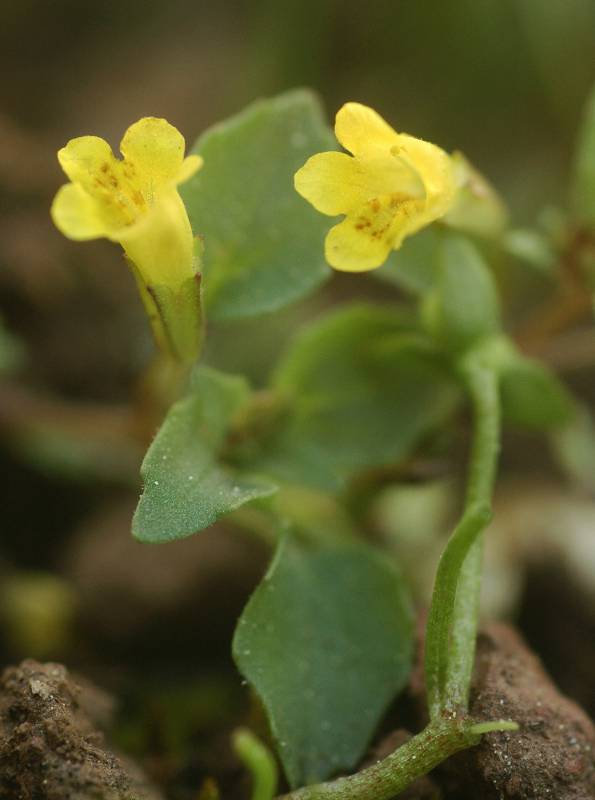Erythranthe breviflora
Erythranthe patula
short-flowered monkey-flower
stalk-leaved monkey-flower
Leaves typically cauline, basal leaves commonly not persisting past flowering;
petiole 1-3 mm;
blade narrowly ovate or elliptic to lanceolate, 5-15 mm long and 2-6 mm broad, mostly even-sized or becoming slightly smaller distally, 3 palmately arranged veins, base becoming narrow, margins entire or finely toothed, apex acute to obtuse, sometimes glandular-hairy as stems.
Leaves cauline, basal ones not persistent;
petioles 8-25 mm;
blade deltate or somewhat ovate to lanceolate, approximately 4-12 mm long and 3-10 mm broad, palmate venation with 3 veins, base rounded to cuneate-truncate, margins usually finely toothed, apex acute to obtuse, surfaces glabrous as stems.
Axillary flowers 10-20, emerging from nodes at mid- to ends of stems; fruiting pedicels not bent or curved, 5-11 mm, glandular-hairy as stems;
calyx winged, ridged, bell-shaped becoming somewhat ovoid-ellipsoid, strongly inflated, 5-6 mm, margins significantly toothed or lobed, sparsely covered with small rigid hairs, no glands or occasionally slightly sessile-glandular, lobes pronounced, erect;
corollas yellow with red spots or stripes, with bilateral symmetry and weakly bilabiate;
tube-throat cylindric to slenderly funnel-shaped, 3.5-5 mm, not protruding past calyx margin;
limb minutely widened, lobes broadly obovate with rounded apexes;
styles glabrous;
anthers not protruding, glabrous.
Axillary flowers 1-10, emerging from nodes throughout; fruiting pedicels 10-25 mm, glandular as stems;
calyx tubular, barely or not inflated, 5-6 mm, margins with distinct teeth or lobes, slightly stipitate-glandular to sparsely hirtellous, lobes pronounced, erect;
corollas yellow, lower limb commonly with some red or brownish dots, symmetric radially or bilaterally, regular or weakly bilabiate;
tube-throat funnel-shaped, 7-8 mm, protruding beyond calyx margin;
lobes oblong, apex rounded to truncate;
styles glabrous;
anthers not protruding, glabrous.
Capsules 4-6 mm, included.
Capsules 4-6 mm, included.
Erythranthe breviflora
Erythranthe patula
- Local floras:
BC,
CA,
OR,
WA
- Local Web sites:
CalFlora,
CalPhotos,
Flora NW,
PNW Herbaria
WildflowerSearch
iNaturalist (observations)
- LBJ Wildflower Center
- SEINet
- Plants of the World Online
- Encyclopedia of Life
- Wikipedia
- Google Image Search
- Local floras:
BC,
OR,
WA
- Local Web sites:
Flora NW,
PNW Herbaria
WildflowerSearch
iNaturalist (observations)
- LBJ Wildflower Center
- SEINet
- Plants of the World Online
- Encyclopedia of Life
- Wikipedia
- Google Image Search



